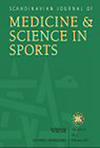Long‐Term High‐Intensity Interval Training Intervention Improves Emotional Conflict Control in Association With Right Ventrolateral Prefrontal Activation in Males With Methamphetamine Use Disorder: A Randomized Controlled Trial
IF 3.5
2区 医学
Q1 SPORT SCIENCES
引用次数: 0
Abstract
Acute high‐intensity interval training (HIIT) has cognitive benefits in individuals with methamphetamine use disorder (MUD), yet it remains largely unknown the benefits of long‐term HIIT on emotional conflict control and its neural mechanism in individuals with MUD. The current study conducted a 36‐week low‐volume HIIT intervention to investigate the effects of HIIT on emotional conflict control in males with MUD and their prefrontal cortex (PFC) activation. This study was a sub‐study of the Study for Rehabilitation Training Model Construction and Training Effect of High Intensity Compound Exercise Prescription. Forty males with MUD (31.50 ± 4.33 years) were randomly assigned to the HIIT group and control group. The HIIT group received a 36‐week low‐volume HIIT intervention, while the control group maintained daily physical exercise. The emotional conflict task (emotional face‐word Stroop task) with functional near‐infrared spectroscopy (fNIRS) recording and subjective craving test were performed before and after the intervention. The results showed that the HIIT intervention reduced the emotional conflict and increased cortical activations of right dorsolateral PFC (dlPFC) and right ventrolateral PFC (vlPFC). More importantly, the HIIT‐induced decreased emotional conflict was associated significantly with increased right vlPFC activation. In addition, subjective craving was also reduced after HIIT intervention. While the control group showed significant changes in neither brain activation nor the craving. These findings suggest that long‐term low‐volume HIIT can improve PFC activation, promote emotional conflict control, and reduce subjective craving in males with MUD. HIIT seems to be an effective method of withdrawal rehabilitation for males with MUD.长期高强度间歇训练干预改善甲基苯丙胺使用障碍男性右腹外侧前额叶激活相关的情绪冲突控制:一项随机对照试验
急性高强度间歇训练(HIIT)对甲基苯丙胺使用障碍(MUD)患者有认知益处,但长期HIIT对MUD患者情绪冲突控制的益处及其神经机制仍不清楚。目前的研究进行了一项为期36周的低容量HIIT干预,以研究HIIT对MUD男性情绪冲突控制及其前额叶皮质(PFC)激活的影响。本研究是“高强度复合运动处方康复训练模式构建与训练效果研究”的一个子研究。40例男性MUD患者(31.50±4.33岁)随机分为HIIT组和对照组。HIIT组接受为期36周的低量HIIT干预,而对照组保持每天的体育锻炼。在干预前后分别进行情绪冲突任务(情绪脸字Stroop任务)和主观渴望测试,并进行功能近红外光谱(fNIRS)记录。结果表明,HIIT干预减少了情绪冲突,增加了右背外侧PFC (dlPFC)和右腹外侧PFC (vlPFC)皮质激活。更重要的是,HIIT诱导的情绪冲突减少与右侧vlPFC激活增加显著相关。此外,HIIT干预后主观渴望也有所减少。而对照组在大脑活动和渴望方面都没有表现出明显的变化。这些研究结果表明,长期低容量HIIT可以改善MUD男性的PFC激活,促进情绪冲突控制,并减少主观渴望。HIIT似乎是男性MUD戒断康复的有效方法。
本文章由计算机程序翻译,如有差异,请以英文原文为准。
求助全文
约1分钟内获得全文
求助全文
来源期刊
CiteScore
7.90
自引率
4.90%
发文量
162
审稿时长
3 months
期刊介绍:
The Scandinavian Journal of Medicine & Science in Sports is a multidisciplinary journal published 12 times per year under the auspices of the Scandinavian Foundation of Medicine and Science in Sports.
It aims to publish high quality and impactful articles in the fields of orthopaedics, rehabilitation and sports medicine, exercise physiology and biochemistry, biomechanics and motor control, health and disease relating to sport, exercise and physical activity, as well as on the social and behavioural aspects of sport and exercise.

 求助内容:
求助内容: 应助结果提醒方式:
应助结果提醒方式:


